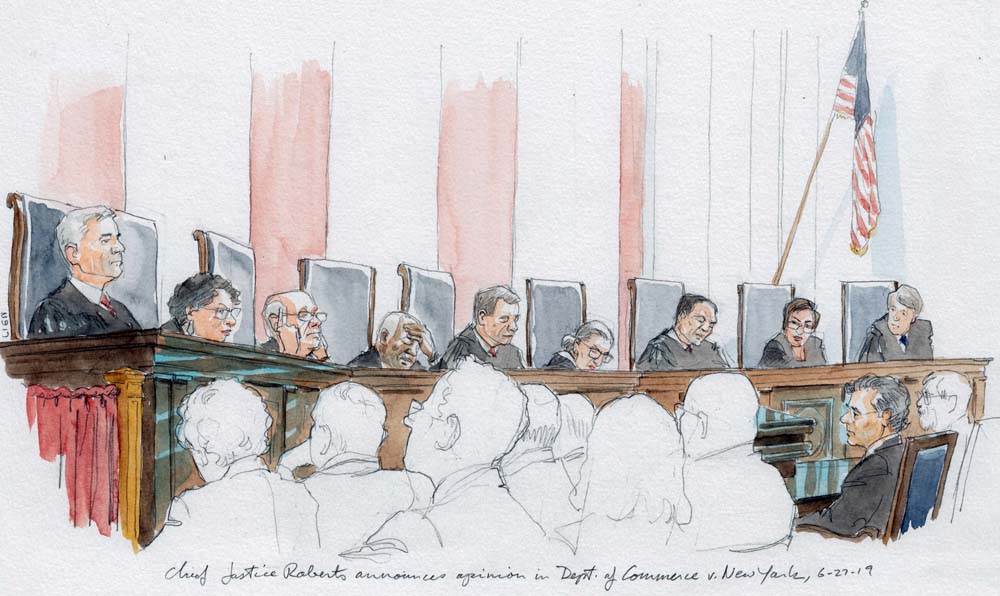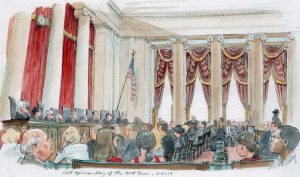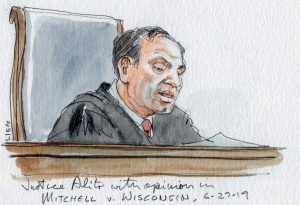A “view” from the courtroom: “With respect but deep sadness”

on Jun 27, 2019 at 6:53 pm

Today, the court intends to announce “all remaining opinions ready” from this term, as Chief Justice John Roberts put it Wednesday. Some cases are more ready than others, it will turn out. But first, we have nearly an hour of some pretty intense drama.
In the bar section, James Swanson, a lawyer and the author of “Manhunt: The 12-Day Chase for Lincoln’s Killer” and other highly readable works of history, is seated next to Tim O’Brien, a former Supreme Court correspondent for ABC News who has worked as a law professor.
In the press section, a longtime regular is here for his last day as full-time Supreme Court correspondent. Tony Mauro is retiring, or at least stepping back, from his job as one of the high-court reporters for the National Law Journal. Mauro began covering the court in 1979 for Gannett News Service. When the Gannett newspaper chain launched USA Today in 1982, Mauro became its correspondent for both the colorful national newspaper and the news service. In 2000, he switched to Legal Times, a Washington-based newspaper that was part of American Lawyer Media. About 10 years ago, Mauro joined Marcia Coyle in covering the court for ALM’s National Law Journal. Mauro has always written clearly about the court, including about some of its lesser-known practices and traditions, and he has not been afraid to hold the justices to account.
Across the courtroom, three court officials have entered and taken seats in the cushy chairs at the front of the VIP section. One is Catherine Fitts, the curator of the court. Another is Jeffrey Minear, the counselor to the chief justice. And in the cushy chair closest to the bench is Christine Fallon, the court’s reporter of decisions.
She works with each justice’s chambers on the syllabus for opinions. Yesterday, she received some friendly advice from Cornell University law professor Michael Dorf, who pointed out in his Dorf on Law blog certain ambiguities in how fractured Supreme Court opinions are identified, such as whether justices who join specified sections of an opinion also necessarily join, say, an introductory paragraph.
At least one of today’s opinions will present some more fodder for such analysis.
In the back rows of the VIP section, we spot only one spouse of a justice this morning. Joanna Breyer, the wife of Justice Stephen Breyer, is here today, as she was on Monday. Sometimes there is some intense speculation about the presence of spouses on the last day of the term and what they may say about potential retirements. (Remember that last year, Mary Kennedy and several members of the Kennedy clan showed up on the last day, with young grandchildren in dress clothes, which was a giveaway of the news that would break that afternoon of Justice Anthony Kennedy’s retirement.)
Many people may be relieved to learn that Joanna Breyer is often in attendance on the last day of the term, so her presence is not necessarily an indication of any impending retirement plans.
When the court takes the bench at 10 a.m., Justice Clarence Thomas is back after being absent yesterday, and so everyone is present. That includes the chief justice, who evidently was scheduled to speak today at the judicial conference of the U.S. Court of Appeals for the District of Columbia Circuit. Supreme Court litigator Kannon Shanmugam has tweeted from the conference site in Westminster, Md., that Roberts’ remarks have been moved to tonight because “he apparently has somewhere else to be this morning.”
Roberts announces that Justice Samuel Alito has the opinion in Mitchell v. Wisconsin, about whether the police need a warrant to draw blood from an unconscious motorist suspected of driving under the influence of alcohol.
Yesterday, Alito had the opinion for the court in Tennessee Wine and Spirits Retailers Association v. Thomas, which addressed another alcohol-related question. This case, he says, marks the third time in recent years involving “state efforts to curb drunk driving.”
Alito provides some details of the arrest of Wisconsin motorist Gerald Mitchell, who failed a field breathalyzer test but “was so drunk he soon fell unconscious” while being transported to a police station, so the police instead took him to a hospital and asked medical personnel to draw a blood sample. That sample showed a blood-alcohol level of 0.222 percent, well above the legal limit.
Mitchell challenged the warrantless blood draw on Fourth Amendment grounds, but the Wisconsin Supreme Court upheld it.
Alito continues describing what turns out to be a plurality opinion, concluding that when police have probable cause to believe a person has committed a drunk-driving offense, and the driver’s unconsciousness or stupor requires him to be taken to a hospital before police can administer a standard breath test, “they may almost always order a warrantless blood test” to measure the driver’s blood-alcohol content “without offending the Fourth Amendment,” he says.
He adds there is the possibility of the unusual case in which a defendant could show that his blood would not have been drawn if police had not been seeking BAC information and that police could not have reasonably considered that seeking a warrant would interfere with their other pressing duties. And because Mitchell did not have the chance to make that showing, his case is remanded.
Thomas has an opinion concurring in the judgment, while Justice Sonia Sotomayor has filed a dissent joined by Justices Ruth Bader Ginsburg and Elena Kagan; and Justice Neil Gorsuch has filed his own dissent.
The chief justice says, “I have the opinion of the court in two cases being decided together.”
They are Rucho v. Common Cause and Lamone v. Benisek, the cases from North Carolina and Maryland, respectively, about partisan gerrymandering.
Roberts lays out the key facts in each, about how Republicans engaged in partisan map-drawing in North Carolina and Democrats did the same in Maryland.
“The long and short of it” is that these are partisan gerrymanders, he says. The legal question is whether the claims brought by challengers under the First Amendment and the elections clause of the Constitution “are justiciable. That is, whether they are suited for resolution by the federal courts.”
He notes that accusations of partisan gerrymandering go back to the first congressional elections, when George Washington accused Patrick Henry of trying to gerrymander districts against Federalist candidate James Madison. “It didn’t work,” Roberts says. Madison prevailed over future president James Monroe.
“There’s no standard in the Constitution” for evaluating such claims, “so what do you, as a judge, do?” the chief justice says to a courtroom of people, most of whom are not judges.
He cites “a justice who served as an Arizona state legislator” and quotes from Sandra Day O’Connor’s opinion in Davis v. Bandemer.
The plaintiffs are seeking “an unprecedented expansion of judicial power,” Roberts says. Partisan-gerrymandering claims present “political questions” beyond the reach of the federal courts.
The judgments of the district courts below are vacated, and the cases are remanded with instructions to dismiss for lack of jurisdiction, the chief justice says. Kagan has a dissent, joined by Ginsburg, Breyer and Sotomayor.
By this time, the law clerk alcoves are so full that some clerks are standing between the pillars.
Kagan dons her reading glasses and begins a summary of her dissent.
“For the first time ever,” she says, “this court refuses to remedy a constitutional violation because it thinks the task beyond judicial capabilities.”
She gives her own factual description of the manipulation of districting lines in the North Carolina and Maryland cases and says, “Now I go back to the question I asked: Is this how American democracy is supposed to work?”
Partisan gerrymandering can make election day meaningless. “By drawing districts to maximize the power of some voters and minimize the power of others, a party in office at the right time can keep itself there for a decade or more, no matter what the voters would prefer,” she says.
“In the face of grievous harm to democratic governance and flagrant infringements on constitutional rights — in the face of escalating partisan manipulation whose compatibility with this nation’s values and law no one defends — the majority declares that it can’t provide a remedy because it can’t find a manageable legal standard to apply,” she says.
“But what the majority says can’t be done has been done,” she adds. “It’s not just possible. Again and again, we’ve seen it happen.”
She goes on for more than 10 minutes, describing the standard used by the district courts and encouraging people to read their “detailed, thorough, painstaking” decisions.
“Of all times to abandon the court’s duty to declare the law, this was not the one,” Kagan says. “The practices challenged in these cases imperil our system of government. Part of the court’s role in that system is defend its foundations. None is more important than free and fair elections.”
As she concludes, Kagan’s voice breaks with emotion. “With respect but deep sadness, Justices Ginsburg, Breyer, Sotomayor, and I dissent.”
The chief justice, who has been looking down at his papers much of the time Kagan was speaking, now looks up to move on to the next case.
“I have the opinion of the court in Number 18-966, Department of Commerce versus New York,” he says, in reference to the big case about the citizenship question on the 2020 census.
With summer here, we are about to go on the periodic roller-coaster ride known as the Chief Justice Express.
“From the beginning, the census was used for much more than just counting the population,” Roberts says, noting questions about household radio ownership and “age at first marriage.”
“Starting in 1820, the census more or less regularly started asking” respondents “whether they were citizens,” he says.
He describes the move of the citizenship question to the “long form” in 1960, and then to the American Community Survey. He discusses the March 2018 decision memo by U.S. Commerce Secretary Wilbur Ross, which noted, among other things, the United Nations recommendation that citizenship data be collected and that other major democracies such as Australia, Germany and the United Kingdom ask such a question.
The roller coaster is going up in the Trump administration’s direction as Roberts explains the majority’s holding that the enumeration clause in the Constitution permits Congress, and by extension the commerce secretary, to inquire about citizenship.
Turning to the Administrative Procedure Act, the chief justice says, “we disagree with the district court’s decision” that the secretary’s decision to reinstate the citizenship question was not supported by the evidence before him.
The secretary’s decision “passes muster” under the very deferential “arbitrary and capricious” standard of the APA, Roberts says.
Solicitor General Noel Francisco, who argued the case for the administration, is in his chair in at the counsel table and seems to be enjoying this ride.
But the roller coaster is about to dive and do a loop-de-loop.
Roberts goes into the complicated history of the Voting Rights Act rationale relied upon by Ross.
The government contends that there was nothing objectionable or even surprising in the secretary’s having made up his mind to reinstate the question before the Department of Justice made its request based on the voting-rights law.
“And we agree—to a point,” Roberts says. It is hardly unusual for a new agency head to come into office with policy preferences and ideas and “the record here reflects the sometimes involved nature of executive branch decisionmaking.”
”And yet, viewing the evidence as a whole, we share the district court’s conviction that the decision to reinstate a citizenship question cannot be adequately explained in terms of [the Justice Department’s] request for improved citizenship data to better enforce the VRA,” Roberts says. “Several points, considered together, reveal a significant mismatch between the decision the secretary made and the rationale he provided.”
Francisco is now holding his hand over his mouth.
“Altogether, the evidence tells a story that does not match the explanation the secretary gave for his decision,” the chief justice says. Here, the sole stated reason for the decision, the voting-rights rationale, “seems to have been contrived,” he says.
“Accepting contrived reasons would defeat the purpose of the enterprise,” he adds. “If judicial review is to be more than an empty ritual, it must demand something better than the explanation offered for the action taken in this case.”
“We do not hold that the agency decision here was substantively invalid,” Roberts says. “But agencies must pursue their goals reasonably. Reasoned decisionmaking under the Administrative Procedure Act calls for an explanation for agency action. What was provided here was more of a distraction.”
And with that, the train pulls back into the loading and unloading area. The chief justice explains the complex voting lineup, with each opinion concurring in part and dissenting in part. Even without the written opinion in hand, we can correctly guess which justices have concurred in the part that has gone against the administration.
There will be much commentary on just what this decision means, including from as far away as Japan, where the president is traveling and tweeting.
Roberts announces that the case of Carpenter v. Murphy, about whether the 1866 territorial boundaries of the Creek Nation within the former Indian Territory of eastern Oklahoma constitute an “Indian reservation” today under federal law, is being restored to the docket for reargument next term.
The chief justice proceeds to his usual last-day rituals, which include announcing that “the court has acted upon all cases submitted the court for decision this term.”
He thanks Supreme Court employees and members of its bar. He notes the retirements during the term of three longtime employees, who are seated in the cushy VIP chairs, per tradition: Private First Class Tracy Anderson, with 28 years on the Supreme Court police force; Private First Class Edwin Haynes, with 25 years of service on the police force; and research librarian Catherine Romano, with 34 years of Supreme Court service, “tying John Marshall’s record,” Roberts quips.
He thanks them and wishes them well in their retirement before Marshal Pamela Talkin bangs her gavel and declare that court is adjourned until the first Monday in October.







